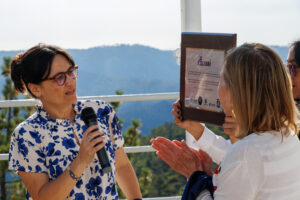COLIBRI on Arte, the Franco-German television station.
Arte Journal, Saturday, May 17, 2025.
Arte Journal, Saturday, May 17, 2025.
October 8, 2025
French proposers are invited to prepare and submit a proposal not exceeding three pages in length (PDF format):
Certain targets are reserved for the COLIBRÍ Consortium under guaranteed time — including the follow-up of transients detected by SVOM, Swift, and Einstein Probe, as well as selected FRBs, TDEs, and similar events. In case of doubt, proposers are encouraged to contact the COLIBRÍ Principal Investigator, Dr. Stéphane Basa (stephane.basa_AT_lam.fr), for clarification.
Both individuals and research groups may submit requests. Each proposal must clearly designate a single technical contact person, providing their name and email address. All correspondence will be conducted with this contact.
Completed requests should be sent directly to the COLIBRÍ PI (stephane.basa_AT_lam.fr). The proposals will then be reviewed by a scientific committee, which may contact the designated technical correspondent prior to the observations in order to request clarification or make recommendations.
In accordance with the COLIBRÍ Memorandum of Understanding (MoU), all proposals and resulting data will be treated with strict professional confidentiality. The Science Operations Team may inspect the data to assess quality and characterize the instrument, but no data will be shared outside the Science Operations and Instrument Teams.
There is no requirement to include members of the Science Operations Team as co-authors on resulting publications. However, all publications should cite the relevant telescope and instrument papers and acknowledge COLIBRÍ, as described in the Observing Manual (link below).
The DDRAGO instrument is currently operating as a single-channel imager with a 26-arcminute field of view, 0.38 arcsecond pixels, and the following filters:
The transients team typically uses 60-second exposures, applying random dithers within a 1-arcminute diameter circle, which provides a good balance between efficiency and sky depth.
Alternative observing strategies are welcome — one of the main goals of this shared-risk phase is to allow observers to explore optimal strategies for their science and share their feedback with the team.
We aim to keep individual observing blocks to about 30 minutes of real time (i.e., 24 × 60-second exposures plus overheads). If more data are needed, proposers are encouraged to schedule repeated blocks.
A simple exposure time estimator is here.
A preliminary observing manual is here. This manual will be updated as the instrument is commissioned.
The COLIBRI ground-based telescope unveiled its first images at its inauguration on September 7, 2024 at the San Pedro Mártir National Astronomical Observatory, Mexico. Designed as part of the SVOM space mission, the outstandingly fast telescope will be able to detect gamma-ray bursts, as well as other transient astronomical phenomena. The project is the result of close collaboration between France and Mexico, and is supported by the Aix-Marseille University, the CNRS, the French space agency CNES, the National Autonomous University of Mexico (UNAM), and Mexico’s National Council of Science and Technology.
The COLIBRI ground-based telescope has the remarkable ability to detect and record random flashes of light in the sky lasting just a few seconds. Designed as part of the SVOM space mission, whose goal is to identify and investigate gamma-ray bursts, this unique instrument, the only one of its kind in the world, will help astrophysicists to attempt to answer a host of questions relating to the study of transient astronomical phenomena, (such as the identification of the astrophysical objects at the origin of gravitational waves, and the sources of high-energy cosmic neutrinos), as well as helping them to understand the early Universe (in particular the identification of the first generation of stars and the study of the first galaxies).
Standing four metres high and weighing eight tonnes, COLIBRI can be pointed at any region of the sky in under 20 seconds. It is equipped with a 1.30 metre mirror and three cameras for simultaneous observations in the visible and infrared range. This robotic telescope carries out observations and surveys without human intervention, using an observation programme, thus further increasing its responsiveness and lowering operating costs.
To date, COLIBRI is the only astrophysics research facility jointly run by France and Mexico, and follows on from a long tradition of collaboration between the two countries, recently consolidated in the form of an International Research Project.
The telescope was fully assembled at the Observatoire de Haute-Provence and its performance tested through field trial for over a year before being shipped to Mexico. COLIBRI is installed at the San Pedro Mártir National Astronomical Observatory, Mexico, where it was inaugurated on September 7 and delivered its first images.


On Saturday 22 June, SVOM was successfully launched from the Xichang base in China. The rocket left at exactly the right second (15h local time) and the satellite is now operating at nominal levels.
COLIBRI has been specially developed for the SVOM mission, whose launch on June 22, 2024 is now imminent.